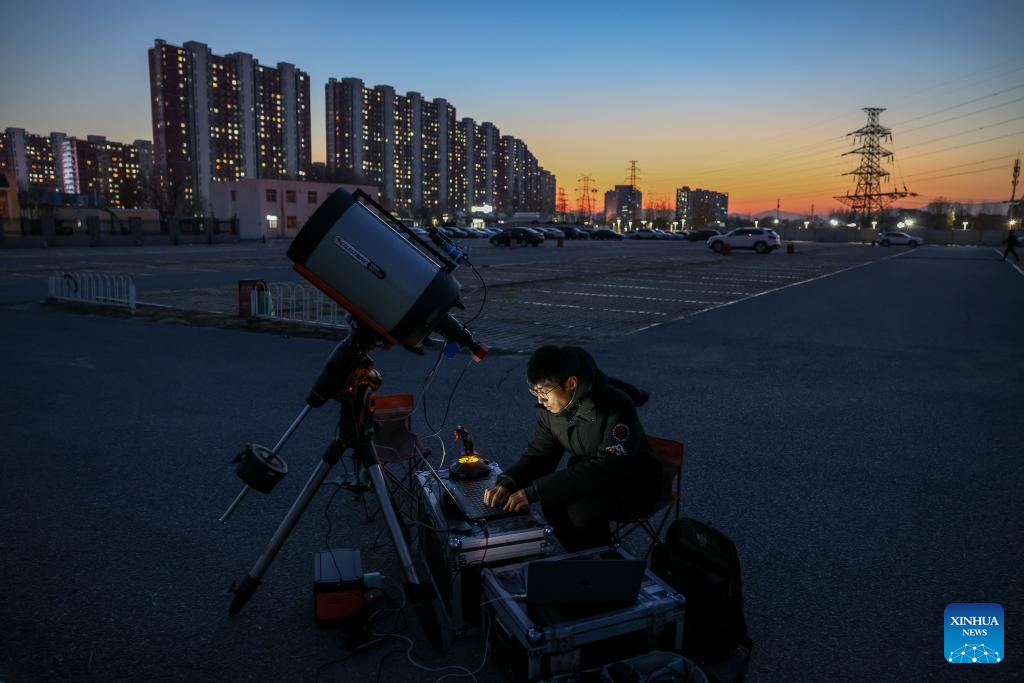13.12.2022

This combo photo shows different configurations of China's space station since April 2022. (Photo by Liu Boyang/Xinhua)
Stargazer, doctor of astrophysics, promoter of astronomy and vlogger -- Liu Boyang has many facets, but the most high-profile is his role as a documenter of China's space station.
In March, Liu began making preparations for his plan -- documenting and sharing the development of the space station so that he can "help more people learn about the development of China's aerospace sector."
"If you haven't captured and witnessed the changes of China's space station, it's hard to imagine that the space station flying above our heads can 'transform' like a robot," he said.
Since April 19, he has captured every configuration of China's space station on film.
In April 2021, the country officially kicked off the in-orbit construction of its space station by launching the core module Tianhe.
The space station features a basic three-module configuration consisting of the core module, Tianhe, and two lab modules, Wentian and Mengtian. It is designed to be a versatile space lab, capable of accommodating 25 experiment cabinets for scientific exploration.
As a full-time wemedia worker, the 32-year-old has spent months this year taking photos of the space station. However, his passion for astronomy goes back much further.
In 1990, Liu was born into an ordinary family in Erdos, north China's Inner Mongolia Autonomous Region. Before entering primary school, his parents took him to many museums and found that he took a special liking to planetariums.
In 1996, Liu received a significant gift -- an entry-level foldable telescope that cost his parents two months' salary.
When he was in senior high school, Liu joined the astronomy club and became one of its leaders, a role that required him to give lectures to other members. To present intriguing lectures, he read many astronomy books and surfed the internet to accumulate knowledge.
During the same period, he observed stars outside for the first time when he went on a stargazing trip with the other club members, using the school's only large aperture reflecting telescope.
"Astronomy does not live in history books, but in real life. Every moment, astronomical teams from across the globe make new discoveries, which help us feel the progress made by humans," he said.
In 2007, Liu's growing curiosity prompted him to major in astronomy at Peking University, and he later pursued his doctoral studies at the University of Western Australia.
During his doctorate years, he began to promote astronomical knowledge on his social media platforms. "We live in an era of the rapid development of science and technology, and it is very interesting to share what we have experienced."
In addition to popularizing astronomy, his idea to photograph artificial celestial bodies gradually came into being.
In 2020, he was surprised that foreign photographers could take close-up images of the International Space Station from the ground. He decided to try his hand at taking similar pictures.
However, photographing moving objects in space from the ground is not as simple as pressing the shutter button. Optical tracking software is needed to control telescope tracking. But the software he was able to find was either outdated or insufficiently designed to function properly.
On March 18 this year, Liu swung into action as he didn't want to miss the best stage to record the growth of China's space station. He decided to develop an optical tracking program himself.
On April 19, with his self-developed optical tracking program, Liu captured clear, close-up images of China's space station for the first time on the outskirts of Hengshui City, north China's Hebei Province, despite failures in the process.
Running after the space station was no easy task for Liu and his team, technically or financially.
The configuration of the space station is constantly changing with the completion of each launch mission. And the ideal conditions for observing and photographing the transit of the space station from the ground are very limited.
To look for better shooting conditions, he has made over 50 trips to carefully selected locations in more than 10 cities across the country, largely at his own expense. He waits patiently for the few minutes when the space station zips across the night sky.
This year, he traveled into the desert and onto plateaus, and almost got lost in the wild without a phone signal. But he says that the challenging experiences were "no big deal."
Thereafter, Liu's stories and the videos he shares garnered media attention, and subscribers flocked to his accounts on platforms including the Chinese online video-sharing platform Bilibili.
His Bilibili subscriber base grew from 2,000 in April to 100,000 in the end of September this year.
So far, he has captured 26 clear, close-up images of China's space station.
The space station will become busier exploring space science and technology in the coming years, as the recently launched Shenzhou-15 mission wraps up the last stage of the station's construction and kicks off the first stage of its application and development.
In addition to promoting astronomy, Liu is participating in the 6-8m Expanding Aperture Segmented Telescope project at Peking University, and he hopes his work will have scientific research and engineering value. ■

Liu Boyang adjusts photographing equipments at a photographing site in Changping District, Beijing, capital of China, Dec. 4, 2022. On that day three Chinese astronauts on board the Shenzhou-14 manned spaceship returned to Earth safely. (Xinhua/Liu Jinhai)

Liu Boyang (C) attends a science popularization activity at a rural primary school in north China's Shanxi Province on Nov. 18, 2021. (Xinhua)
Quelle: Xinhua
